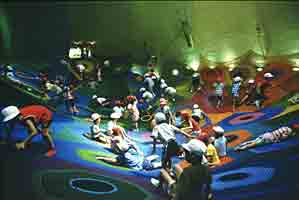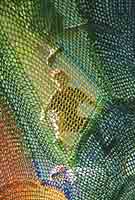![]()
horiuchi
Takino Suzuran Hillside National Park, Sapporo, Japan


Horiuchi called the work which resulted from her change of direction, 'Sculpture for Children'.
She describes the various factors that lead to this shift.
Ever since her earliest work as a designer with a New York interior textile company she had been pondering the question, 'what is cloth?'. It was a question that continued to intrigue her. Cloth, she concluded, is a second skin and so, like skin, it is thin, it stretches and is comfortable to the touch and it is porous. Like skin, it can breath - a perforated membrane.

It was while she was trying to capture this notion within her work in a joint project with Naoko Furue in 1971 that she first discovered that there was another 'human' aspect to the essence of cloth that she had overlooked.
It all happened quite by accident. Two children had entered the gallery where she was exhibiting 'Multiple Hammock No. 1' and, blissfully unaware of the usual polite protocols that govern the display of fine art, asked to use it. She watched nervously as they climbed into the structure, but then was thrilled to find that the work suddenly came alive in ways she had never really anticipated. She noticed that the fabric took on new life - swinging and stretching with the weight of the small bodies, forming pouches and other unexpected transformations, and above all there were the sounds of the undisguised delight of children exploring a new play space. She felt it was almost as if she had discovered a new dimension. The children played with such abandon that it was almost as if they were playing inside a mothers womb.
It's probably no coincidence that all of this corresponded with the birth of her own son at the age of 44 and a move in 1988 to her husband's home area in Nova Scotia, Canada. All of this reinforced her interest in 'play structures as a beautiful 3D art form'. She felt more and more that playing with or on soft materials was an important part of a child's development.
There was, however, to be a further highly personal moment of revelation that would deliver her a sense of motivation that has stayed with her to this day. She was touring Europe the following year with her husband, Charles MacAdam, and they had deliberately decided that, for once, 'art' was going to take a back seat. Art, however, was not so easily left behind, and in a small, local church in Italy she saw something that would astonish her - the local people were kneeling and praying in front of a group of fresco paintings by Giotto. It was a scene that filled her with a sense of purity, and left behind a persistent vision that art and life could be so intimately and innocently bound up with each other. From now on she knew that she would focus on this area of art where children and their responses would be the ultimate arbiters her works quality and beauty.
Some time after returning to Canada Horiuchi and her husband, Charles MacAdam, established Interplay Design & Manufacturing Inc. in Canada (IPC) and Interplay Japan (IPJ) in Japan as vehicles with which to pursue these new ideas.

